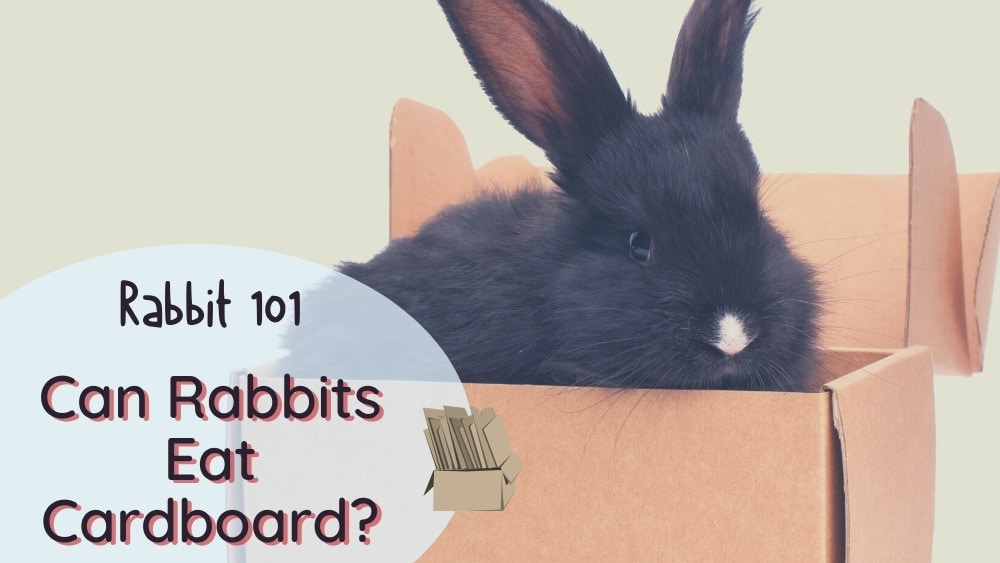Rabbits love chewing cardboard. I’ve cared for dozens of bunnies over the years and every single one of them will rip into a brown cardboard box with vigor.
It’s fun to watch bunnies indulge their gnawing and nesting instincts with such cheap entertainment, but the question always bothered me: Is it really safe for rabbits to chew on cardboard? What if they eat it? Can they digest it? What if it contains ink, chemicals, or adhesive?
I’ve never seen a rabbit get indigestion from chewing on cardboard – and neither has my vet – but I decided to dig up answers to those questions that were more than anecdotal.
In this article, we’ll look at
- The reasons why rabbits love to chew cardboard.
- Materials and chemicals used in cardboard production
- How to weigh the risks of giving it to your bunny.
- Benefits of using DIY cardboard rabbit toys.
Can Rabbits Eat Cardboard?
Yes, rabbits easily shred, chew, and eat cardboard – and they can digest it also. Cardboard is made of plant cellulose, a fiber that rabbits consume a lot of in their hay-based diets. However, since cardboard has no nutrition and may include chemical inks and binders, you should not let your rabbit eat too much of it.
Why Do Rabbits Chew Cardboard?
A busy bunny is a happy bunny. Several instincts drive rabbits to be constantly digging and chewing – and if a cardboard box is available, it frequently becomes the target.
One reason rabbits are drawn to cardboard is that they need huge amounts of dietary fiber. The bulk of a rabbit’s digestion happens in a very large “hindgut” called a cecum. The cecum functions similarly to the rumen in cattle; it’s filled with special microbes that ferment coarse plants like hay and release enzymes to pull nutrients from it.
One of these enzymes is called cellulase. It’s the enzyme that breaks down cellulose – or the plant fiber that cardboard is made from.
Bunnies crave a constant supply of dietary cellulose to keep their gut bugs happy. In fact, a rabbit’s desire to chew on cardboard may increase when a bunny’s tummy is upset.
Another reason why rabbits like to gnaw fibrous material like cardboard is that it’s critical for their dental health. Rabbit incisors grow about 1 mm per month for a bunny’s entire life. If a rabbit doesn’t wear down its “open-rooted” teeth by chewing on tough stuff, the lower incisors can grow up into the bunny’s nose!
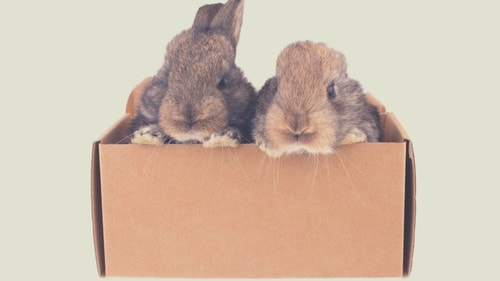
And lastly, bunnies just want to have fun. Shredding cardboard satisfies a rabbit’s nesting and burrowing instincts and will quickly become a favorite pastime.
Will Eating Cardboard Hurt a Rabbit?
Just because bunnies can chew cardboard doesn’t mean it’s healthy, right?
We said that rabbits need a ton of fiber in their daily diets, but not all fiber is equal. Rabbits need high-quality fiber, ideally from second-cutting Timothy hay. Eating large amounts of cardboard might fill a bunny’s tummy, but it won’t provide vitamins or nutrients.

Make sure your rabbits have round-the-clock access to hay so they won’t turn to cardboard to satiate their need for fiber.
Will Eating Cardboard Cause GI Stasis?
As concerned pet owners, we hear tragic stories of rabbits chewing on carpets, plastic toys, or other indigestible materials that later block their digestive tracts. Thankfully, though, this is unlikely to happen with cardboard.
Cardboard is made primarily of wood that has been mechanically or chemically turned into a fibrous pulp. Rabbits can digest the wood pulp, so it probably won’t stop a bunny’s GI tract unless the rabbit eats copious amounts of it.
Plain, uncoated, unprinted cardboard or paperboard is relatively safe for rabbits to chew on.
Every bunny is different, but most rabbits will shred and nest with cardboard rather than actually swallow it. This means you’ll need to pick up the scraps that spread around your home, but that’s better than your rabbit eating something it shouldn’t, right?
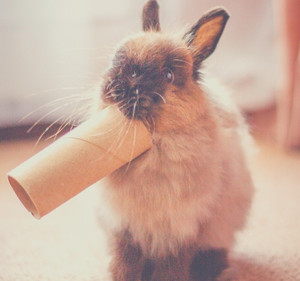
If it seems like your rabbit is truly eating large quantities of cardboard, not just playing with it, you should offer different toys. Increase the amount of healthy fiber in your rabbit’s diet and keep added starches or treats to a minimum. Talk to your veterinarian if your bunny chews its fur or seems to need more fiber than a balanced diet provides; this may be a subtle sign of health problems.
What About Printed or Glossy Cardboard – Is it Toxic?
Since rabbits can digest wood pulp, the biggest concern with letting your rabbit eat cardboard is sulfites, sulfates, and other substances in this list of 300 chemicals that can be used in paper production.
Are these chemicals safe for rabbits to consume? Are they present at high-enough levels in cardboard boxes to be dangerous for bunnies? It is impossible to know.
Inks on Printed Cardboard or Newspaper
Are inks of concern? Most newspapers and food packages are printed with soybean oil-based inks, though some are water-based or petroleum-based.
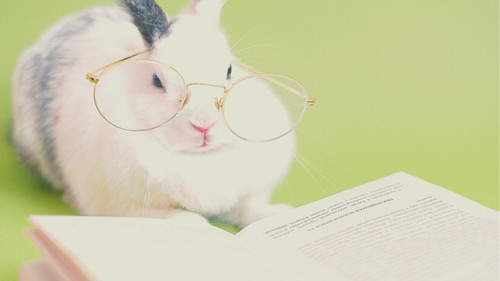
Soybean oil is safe for rabbits in the minuscule amounts that they would ingest when chewing on newspaper or cardboard. The pigments added to the soybean oil are more concerning. These pigments might include ingredients like cadmium or sulfur, but the quantities are very small.
Glossy or Foil Coatings on Cardboard
The coating on glossy cardboard is usually a chemical mix of waxes, plastics, and starches.
The dose makes the poison, of course, and I’ve never heard of a rabbit being poisoned by chewing on a coated cereal box, but it’s safer to stick to uncoated cardboard or paper.
Avoid pizza boxes or grease-resistant paper plates, because these contain PFAS (aka “forever chemicals”) that are linked to kidney cancer.
And if cardboard food packaging clearly has a plastic or a foil lining (like a kid’s juice box), then definitely keep it away from your bunny!
Adhesives and Binders
Ever wonder what the glue holding together a paper-towel tube is made from? Before you give it to your pet to eat, you should!
According to HAR Adhesive technologies, the glue could be made from a starch polymer called dextrin – which is perfectly safe to eat– or it could be made from the more alarming polyvinyl acetate. The American Polymer Standard Corporation says that polyvinyl acetate “may be harmful if swallowed,” because it could “cause intestinal blockage.” Eek!
So even though toilet paper tubes stuffed with hay make great DIY bunny toys, you should skip all cardboard with glue on it.
Is Newspaper or Paper Towel Safe for Rabbits to Shred?
Newspaper is safe for rabbits to shred. The biggest concern is pigments or drying agents added to soy ink, but it’s unlikely that rabbits will swallow very much newspaper. Unprinted brown packing paper is also a great option for shredding.
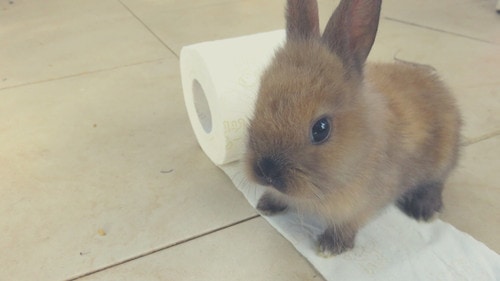
My bunny Carlos’s favorite activity is to shred a sheet of paper towel. Paper towel fiber, although usually bleached, is safe for rabbits to eat. Two-ply paper towels are bound together with glue, but thankfully the glue is made of food-safe ingredients like gelatin or corn sugar.
Benefits of Cardboard Toys for Rabbits
Cardboard, when safely sourced, can have several benefits for rabbits.
- Enrichment – You can make a tunnel or castle with cardboard packaging, or fill a box with paper scraps to create a digging station for your bunny.
- Dental Health – Chewing cardboard helps a rabbit’s teeth wear properly and gives it something interesting to do. I once rescued a rabbit with malocclusion who had been so bored that he gnawed on his cage wire and pulled his teeth out of alignment. Could cardboard have prevented it? Maybe!
- Reduce Destructive Behavior – When your bunny is busy shredding cardboard, it is more likely to leave your rug or wood trim alone. (See “how to bunny proof a room” for more tips on protecting your belongings from rabbit teeth.)
- Saves Money – In the age of online shopping, cardboard and brown packing paper are the cheapest bunny toys you’ll find. I can’t be the only one that takes a pile of Amazon boxes out to recycling each week!
Alternatives to Cardboard Toys for Bunnies
If you’re not comfortable giving your rabbits cardboard because of concerns with pigments, glues, or chemicals, I don’t blame you. It’s nearly impossible to find out exactly what processes or synthetic products were used in the construction of a particular cardboard box.
There are lots of other options for keeping your rabbit’s mind, gut, and teeth in good shape! Here are our favorite non-toxic alternatives to cardboard boxes or toys:
- Wooden Houses. Your bunny can climb under, over, or through its own wooden castle!
- Grass Mats or Huts. Woven grass mats and huts get consumed quickly, but bunnies adore them.
- Willow or Apple Wood Chew Sticks. Hardwood chew sticks – especially these ones from Oxbow Animal Health – are 100% safe for your rabbit and keep them busy for a long time.

Conclusion
Upcycling cardboard packaging is an inexpensive and relatively safe way to enrich a rabbit’s habitat with tunnels, hiding boxes, or DIY toys. Avoid coated, glossy, printed, or grease-resistant cardboard, and choose plain brown corrugated cardboard or paperboard instead.
If you have any concerns about offering your rabbit cardboard, or your bunny seems inclined to eat large amounts of it, talk to your veterinarian. Each rabbit has unique gut microflora, and cardboard might not be a good option for your bunny’s particular needs.
Have you created a cardboard castle for your rabbit? Let us know in the comments!


